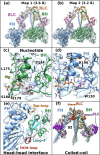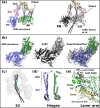Cryo-EM structure of the folded-back state of human β-cardiac myosin
- PMID: 37258552
- PMCID: PMC10232470
- DOI: 10.1038/s41467-023-38698-w
Cryo-EM structure of the folded-back state of human β-cardiac myosin
Abstract
To save energy and precisely regulate cardiac contractility, cardiac muscle myosin heads are sequestered in an 'off' state that can be converted to an 'on' state when exertion is increased. The 'off' state is equated with a folded-back structure known as the interacting-heads motif (IHM), which is a regulatory feature of all class-2 muscle and non-muscle myosins. We report here the human β-cardiac myosin IHM structure determined by cryo-electron microscopy to 3.6 Å resolution, providing details of all the interfaces stabilizing the 'off' state. The structure shows that these interfaces are hot spots of hypertrophic cardiomyopathy mutations that are thought to cause hypercontractility by destabilizing the 'off' state. Importantly, the cardiac and smooth muscle myosin IHM structures dramatically differ, providing structural evidence for the divergent physiological regulation of these muscle types. The cardiac IHM structure will facilitate development of clinically useful new molecules that modulate IHM stability.
© 2023. The Author(s).
Conflict of interest statement
The authors declare no competing interests.
Figures





Update of
-
Cryo-EM structure of the folded-back state of human β-cardiac myosin.bioRxiv [Preprint]. 2023 Apr 18:2023.04.15.536999. doi: 10.1101/2023.04.15.536999. bioRxiv. 2023. Update in: Nat Commun. 2023 May 31;14(1):3166. doi: 10.1038/s41467-023-38698-w. PMID: 37131793 Free PMC article. Updated. Preprint.
Similar articles
-
Cryo-EM structure of the folded-back state of human β-cardiac myosin.bioRxiv [Preprint]. 2023 Apr 18:2023.04.15.536999. doi: 10.1101/2023.04.15.536999. bioRxiv. 2023. Update in: Nat Commun. 2023 May 31;14(1):3166. doi: 10.1038/s41467-023-38698-w. PMID: 37131793 Free PMC article. Updated. Preprint.
-
A FRET assay to monitor different structural states of human β-cardiac myosin including the interacting-heads motif.Proc Natl Acad Sci U S A. 2025 Aug 26;122(34):e2504562122. doi: 10.1073/pnas.2504562122. Epub 2025 Aug 20. Proc Natl Acad Sci U S A. 2025. PMID: 40833405 Free PMC article.
-
Dilated cardiomyopathy mutation E525K in human beta-cardiac myosin stabilizes the interacting-heads motif and super-relaxed state of myosin.Elife. 2022 Nov 24;11:e77415. doi: 10.7554/eLife.77415. Elife. 2022. PMID: 36422472 Free PMC article.
-
Three perspectives on the molecular basis of hypercontractility caused by hypertrophic cardiomyopathy mutations.Pflugers Arch. 2019 May;471(5):701-717. doi: 10.1007/s00424-019-02259-2. Epub 2019 Feb 15. Pflugers Arch. 2019. PMID: 30767072 Free PMC article. Review.
-
Hypertrophic cardiomyopathy and the myosin mesa: viewing an old disease in a new light.Biophys Rev. 2018 Feb;10(1):27-48. doi: 10.1007/s12551-017-0274-6. Epub 2017 Jul 17. Biophys Rev. 2018. PMID: 28717924 Free PMC article. Review.
Cited by
-
Autoinhibition and activation of myosin VI revealed by its cryo-EM structure.Nat Commun. 2024 Feb 8;15(1):1187. doi: 10.1038/s41467-024-45424-7. Nat Commun. 2024. PMID: 38331992 Free PMC article.
-
Cryo-EM structure of the human cardiac myosin filament.Nature. 2023 Nov;623(7988):853-862. doi: 10.1038/s41586-023-06691-4. Epub 2023 Nov 1. Nature. 2023. PMID: 37914935 Free PMC article.
-
Various challenges in understanding the thick filaments, within and outside skeletal and cardiac muscles.Biophys Rev. 2025 Feb 27;17(3):829-834. doi: 10.1007/s12551-025-01289-8. eCollection 2025 Jun. Biophys Rev. 2025. PMID: 40727670 Free PMC article.
-
Remodeling of skeletal muscle myosin metabolic states in hibernating mammals.Elife. 2024 May 16;13:RP94616. doi: 10.7554/eLife.94616. Elife. 2024. PMID: 38752835 Free PMC article.
-
From amoeboid myosin to unique targeted medicines for a genetic cardiac disease.Front Physiol. 2024 Oct 28;15:1496569. doi: 10.3389/fphys.2024.1496569. eCollection 2024. Front Physiol. 2024. PMID: 39529926 Free PMC article. Review.
References
Publication types
MeSH terms
Substances
Grants and funding
LinkOut - more resources
Full Text Sources

